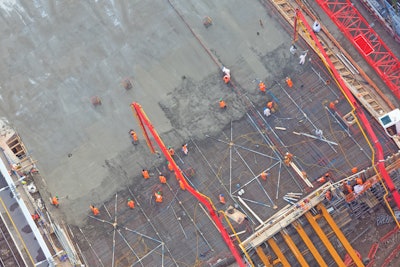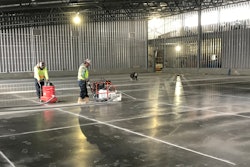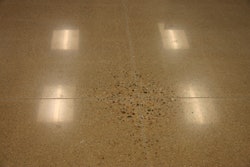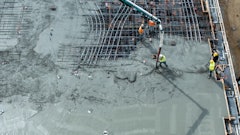
Cement consumption is one of the best ways to analyze and predict strength in the concrete industry, and so far, all signs point to another positive year.
While it’s likely that the economy has hit its peak, the industry is still expected to see modest growth at least for the next few years. In its Fall Forecast released in October 2019, the Portland Cement Association (PCA), whose members represents 91% of the U.S. cement production capacity, predicted moderate cement consumption growth of 1.7% in 2020 and 1.4% in 2021.
“The economy doesn't have the zip and the vigor that it had 10 years ago, and so what we're seeing is the economy's now in late stages of economic growth and recovery. That suggests that overall growth is going to start to slow, which is reflected in a slowdown in GDP numbers. It's also reflected in our slow-down in job creation numbers,” explains Ed Sullivan, senior vice president and chief economist for the Portland Cement Association.
The pillars of economic strength are consumer spending and the labor market. How either one varies month-to-month gives economists a clear picture of economic health.
“If we see any decay in the job creation numbers that come out monthly, or we see significant changes in some of the consumer numbers like vehicle sales, that would give us pause and concern,” Sullivan explains.
Right now, however, Sullivan says both are doing just fine, adding that not only is the jobs market strong, but wages are also beginning to accelerate slightly, and home prices continue to rise. Add to that prices that are relatively tame in terms of inflation and low interest rates, and Sullivan says you have “a cocktail of really favorable consumer spending attitude.”
“You have a willing and able consumer, so if you’ve got the consumer, the economy’s going to be in fairly good shape,” he adds.
Since releasing the Fall Forecast, Sullivan says that residential construction has gained some strength, indicating cement consumption could be slightly stronger than 1.7% next year.
“We're seeing now in the latest tracking that residential single-family starts could represent as much as a million tons more in cement consumption. So that's the biggest change I see going forward next year,” he adds.
Skilled Labor Shortage to Continue
Even with the backing of a strong economy, concrete contractors should still expect to face a number of challenges this year. Most notable will be the continuing shortage of skilled labor.
“The good news is certainly that the workload is going to be robust, but on the other hand, that means we don’t have all the folks we need in the construction industry,” says Randall W. Poston, senior principal at Pivot Engineers and president of the American Concrete Institute (ACI).
Construction, along with health care and personal care, will account for one-third of all new jobs through 2022, according to the Bureau of Labor Statistics. But, 70% of construction companies nationwide are having trouble finding qualified workers, according to the Associated General Contractors of America.
A strong economy with a low rate of unemployment is one culprit for the labor gap.
“Unemployment is still going to be well below what the natural rate is—somewhere between 3.5 and 3.8 this year—and that suggests that the skill shortage continues for construction,” Sullivan says.
A continued disinterest from America’s youth, however, is still the bigger cause of the industry’s ongoing struggle. Organizations such as the National Ready Mixed Concrete Association (NRMCA) and ACI are working to combat this by offering several educational, training and certification programs.
“There's a lot of concern to this day and it has been for many years about the labor shortages in the concrete industry. Drivers are scarce, and they're unpredictable…but the NRCMA is doing a lot of very positive things as far as putting programs in place such as driver training, recruitment and retention to try and help that situation,” says NRMCA President Michael Phillips.
ACI’s focus is on certification, ensuring that those who do enter the workforce are already trained for it.
“A lot of projects require [ACI certification] in their contract documents, so we're really trying to encourage people that are going to work in this industry, particularly at the workmen level, that they're qualified to do the work,” explains Poston. “That's really our biggest program in order to make sure we have a qualified workforce.”
Debt Levels Could Impact Infrastructure Funding
The growing national debt is one area of concern often ignored, which Sullivan says could have lasting impacts on the construction industry. Today there is an enormous need to expand infrastructure but little idea how to pay for it—and the upcoming election further complicates that.
While many candidates are campaigning on issues such as free college education, student loan forgiveness or healthcare for all, each comes with a cost that could further expand the national debt level.
“Many people believe that a new infrastructure plan beyond the FAST Act could be in the cards for the next president. But unless they figure out a way to pay for it without adding to this huge deficit, I don’t see it happening,” Sullivan says. ““It took from George Washington all the way to Ronald Reagan to generate our first $1 trillion in federal debt, and we’re doing that every year now. The debt is enormous.”
And because of that Sullivan further adds that “Debt is going to play an increasingly important role as we go forward the next four years or so.”
Phillips and the NRMCA’s outlook on infrastructure is slightly more positive, but he too acknowledges that the 2020 election will impact how the federal government moves forward on the issue.
“It's a pretty good forecast for 2020, but there's this thing called an election that's looming at the end of the year—and I think that's obviously the wild card,” he says. “We’re in a state today that’s very pro-business, very regulatory responsible and also pro-infrastructure. The election really is going to have a huge effect on which party gets into power and whether those types of things continue or not.”
Phillips remains confident though that an infrastructure plan is not off the table no matter who is in power.
“Our economy, our infrastructure, the roads that we travel on and move goods and services, that is a competitive advantage for us in this country, and it has deteriorated to a point where something needs to get done. When they finally focus on some of the things that are important to the American public, I think that they'll get to infrastructure,” he concludes.
Resilient Buildings Offer Future Opportunities
Climate change—and the extreme weather events that are increasing as a result—have spurred a new debate in regards to constructing homes and buildings with concrete versus wood. While we have been buildings homes with light-frame wood construction since the 1950s, a need for more resilient construction is growing.
“While each region of the U.S. faces a unique combination of weather hazards, every state in the country has been impacted by at least one billion-dollar disaster event since 1980," says Adam Smith, an applied climatologist with the National Oceanic and Atmospheric Administration (NOAA) in Ashville, N.C., who tracks extreme weather events that cause more than $1 billion in damage.
"Over the last four decades (1980-2019), the U.S. has sustained 250 separate weather and climate disasters where overall damages/costs exceeded $1 billion (including Consumer Price Index adjustment to 2019). The total cost of these 250 events exceeds $1.7 trillion,” he adds.
The concrete industry has a huge opportunity to not only offer a solution to this devastation with more resilient homes and buildings, but also to save lives.
Sustainability Gains Traction
The demand for a green environment and sustainability will continue to evolve this year within the industry. The cement industry, which is major component in concrete, unfortunately seems to get a black eye in terms of sustainability—something Poston says is “probably unjustifiable in some ways.”
“It certainly takes a lot of energy to produce cement, but when you look at the other side of the equation and look at resiliency of concrete and its durability, you get much longer life out of a concrete structure,” he notes.
Phillips agrees, adding that “correcting the false narrative” is at the top of the NRMCA’s to-do list in 2020.
“We have a tremendous story to tell from a concrete perspective on the contributions we've made to society, to human health, to life safety to resilient communities, and that's all wrapped in being able to tell a very truthful and fact-based narrative about the impacts of concrete in these carbon discussions that we're having,” he says.
Combined the cement and concrete industries are the second largest industrial emitters of CO2 on the planet, accounting for about 8% of global CO2 emissions. Phillips suggests, however, that concrete’s natural ability to absorb atmospheric carbon will allow the industry over time to be part of climate change solution.
A 2016 paper in Nature Geoscience supports this claim, suggesting that the world's concrete has been absorbing about 43% of those original emissions. There may be some ways to speed up or strengthen this absorption process, which is an area that scientists are still working on.
In the meantime, the NRMCA is working on engaging its members and producers throughout the industry to take an interest in the topic.
“This is an issue that needs full engagement from our members and other producers,” Phillips adds.
And while, blaming the world’s environmental woes on the concrete industry is far from fair, there will continue to be interest in alternative options for sustainable building.
“It’s not coming from all directions, but I can feel an upsurge and the need for that,” Poston says, pointing specifically to long-term investors or property owners and public agencies.
In preparing for that upsurge, ACI updated its most recent building code from ACI 318 19 to include provisions that allow for recycled aggregates and alternative cements that don’t have as much portland cement. It is the first-time using alternatives has been codified.
“We’ve given the nod to those that are acceptable, but they have to demonstrate certain performance requirements before they are utilized on a project,” Poston notes.
Technology Keeps Advancing
The use of technology to make life easier, more efficient and profitable for the contractor will continue to trend.
ACI, for example, has plans to rollout an interactive building code called 318 Plus that will make it easier to keep up with ever-changing codes.
“There’s this feeling from designers that we're getting more and more codes and they're changing all the time. How do we keep up with all this,” Poston says.
In addition to a reorganization of the codes, this program will allow you to look at diagrams in 3D.
“Everybody thinks that, unfortunately, the concrete industry doesn't adapt that well to those sorts of things,” Poston notes. “But now more than ever, when you walk out on a jobsite, the contractor, their supervisors and foreman all have tablets, and information is being sent over from the office directly to them in the field.
“It’s much more real time kind of access to things on a project,” he adds.
Poston also points to a growing trend in modularization, where large portions of a structure are build offsite and the brought in to be installed.
Currently, modular construction accounts for only 5% of all commercial construction in the U.S., according to the Modular Building Institute, but it is growing. McKinsey & Co. estimates market value for modular in new real estate construction could reach $130 billion in Europe and the U.S. in the next decade.
Aging Economy Vulnerable to Global Risk
For 2020 at least, all signs point to a positive year. It is important to note, however, that the economy has reached its peak and may be more susceptible to risks from global economic activity and global political instability.
“It's important to recognize that when we say this economy is getting older, that it's lost some its zip, that the growth rates will ease a little bit, what we're also saying is that increasingly, as the economy ages, it becomes more vulnerable to shocks,” Sullivan notes.
He points to Brexit, for example, which could cause a slow down of the global economy that could have an adverse impact on the construction industry. There are also unknowns in the Middle East and a threat of ware that could also have an adverse impact.
“The most important way in which these external events could impact us is by hitting the consumer psyche or consumer sentiment,” Sullivan adds, explaining that if the consumer is less confident in the economy, they typically keep their money in their pocket.
But, the fundamentals Sullivan sees in place right now suggest a continuation of the last several years, including modest economic growth, modest construction spending growth and modest demand consumption growth.
Poston further adds that while we are all aware that this long period of expansion will come to end at some point, it doesn't look like it's going to happen this year.
“Things could change in a minute, but it's a pretty positive sign when you look at the number of projects that are in the development stage and in the design stage,” he adds. “There’s going to be a lot of construction starting on those projects this year as well as things coming to completion. As I travel around the country, there’s no doubt that whatever state you're in the new state bird is the construction crane.”



















